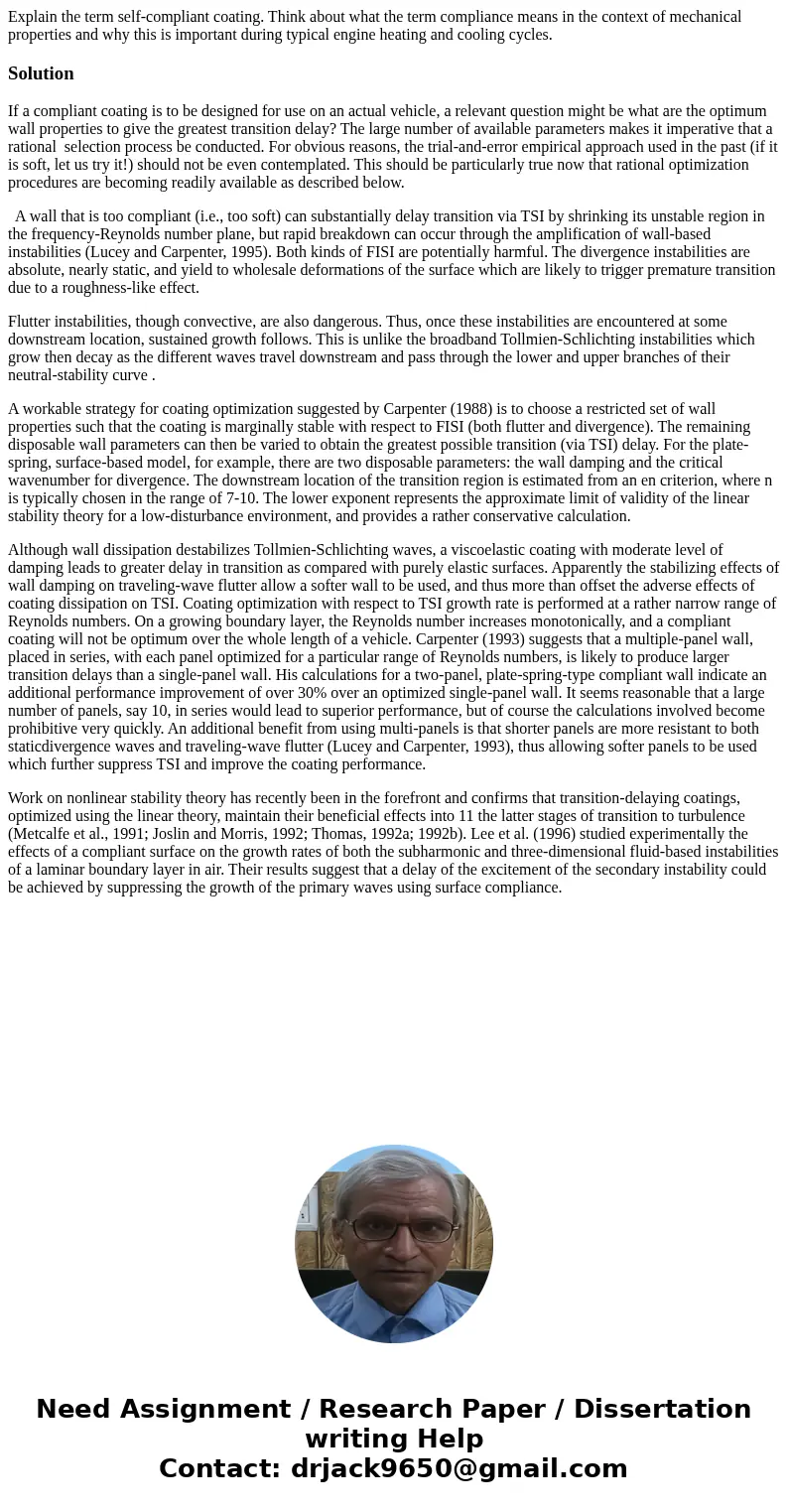Explain the term selfcompliant coating Think about what the
Solution
If a compliant coating is to be designed for use on an actual vehicle, a relevant question might be what are the optimum wall properties to give the greatest transition delay? The large number of available parameters makes it imperative that a rational selection process be conducted. For obvious reasons, the trial-and-error empirical approach used in the past (if it is soft, let us try it!) should not be even contemplated. This should be particularly true now that rational optimization procedures are becoming readily available as described below.
A wall that is too compliant (i.e., too soft) can substantially delay transition via TSI by shrinking its unstable region in the frequency-Reynolds number plane, but rapid breakdown can occur through the amplification of wall-based instabilities (Lucey and Carpenter, 1995). Both kinds of FISI are potentially harmful. The divergence instabilities are absolute, nearly static, and yield to wholesale deformations of the surface which are likely to trigger premature transition due to a roughness-like effect.
Flutter instabilities, though convective, are also dangerous. Thus, once these instabilities are encountered at some downstream location, sustained growth follows. This is unlike the broadband Tollmien-Schlichting instabilities which grow then decay as the different waves travel downstream and pass through the lower and upper branches of their neutral-stability curve .
A workable strategy for coating optimization suggested by Carpenter (1988) is to choose a restricted set of wall properties such that the coating is marginally stable with respect to FISI (both flutter and divergence). The remaining disposable wall parameters can then be varied to obtain the greatest possible transition (via TSI) delay. For the plate-spring, surface-based model, for example, there are two disposable parameters: the wall damping and the critical wavenumber for divergence. The downstream location of the transition region is estimated from an en criterion, where n is typically chosen in the range of 7-10. The lower exponent represents the approximate limit of validity of the linear stability theory for a low-disturbance environment, and provides a rather conservative calculation.
Although wall dissipation destabilizes Tollmien-Schlichting waves, a viscoelastic coating with moderate level of damping leads to greater delay in transition as compared with purely elastic surfaces. Apparently the stabilizing effects of wall damping on traveling-wave flutter allow a softer wall to be used, and thus more than offset the adverse effects of coating dissipation on TSI. Coating optimization with respect to TSI growth rate is performed at a rather narrow range of Reynolds numbers. On a growing boundary layer, the Reynolds number increases monotonically, and a compliant coating will not be optimum over the whole length of a vehicle. Carpenter (1993) suggests that a multiple-panel wall, placed in series, with each panel optimized for a particular range of Reynolds numbers, is likely to produce larger transition delays than a single-panel wall. His calculations for a two-panel, plate-spring-type compliant wall indicate an additional performance improvement of over 30% over an optimized single-panel wall. It seems reasonable that a large number of panels, say 10, in series would lead to superior performance, but of course the calculations involved become prohibitive very quickly. An additional benefit from using multi-panels is that shorter panels are more resistant to both staticdivergence waves and traveling-wave flutter (Lucey and Carpenter, 1993), thus allowing softer panels to be used which further suppress TSI and improve the coating performance.
Work on nonlinear stability theory has recently been in the forefront and confirms that transition-delaying coatings, optimized using the linear theory, maintain their beneficial effects into 11 the latter stages of transition to turbulence (Metcalfe et al., 1991; Joslin and Morris, 1992; Thomas, 1992a; 1992b). Lee et al. (1996) studied experimentally the effects of a compliant surface on the growth rates of both the subharmonic and three-dimensional fluid-based instabilities of a laminar boundary layer in air. Their results suggest that a delay of the excitement of the secondary instability could be achieved by suppressing the growth of the primary waves using surface compliance.

 Homework Sourse
Homework Sourse